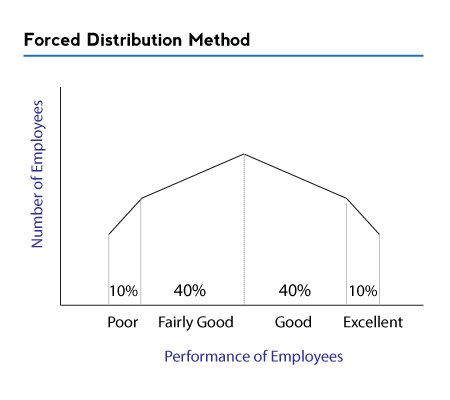Performance appraisal is the technique of appraising employees. Under this method, performance of employees are at first documented then evaluated with the mutually set performance standards.
Companies have been practicing various methods of appraising employee performance, among which some popular ones are described below.
- Essay method
- Comparative evaluation
- Rating
- Forced distribution method
- Forced choice method
- Graphic rating scale method
- Field review method
- Checklist
- Confidential report
- Critical incident method
- Management by objectives (MBO)
- Behaviorally anchored rating scales (BARS)
- Cost accounting method
- 360-degree appraisal
Essay method
It is a traditional and judgmental approach under which employee is evaluated and a descriptive essay is written on him/her. The essay describes in detail about the strengths, weaknesses, potential, nature, etc.
Essay method helps in collecting a lot of information about the employees as the evaluators are not confined to appraise the employees in rigidly defined criteria. The process is unrestricted and flexible, permitting the employers to emphasize on any issues or traits that they feel relevant.
However, this method is tedious and difficult to manage as it demands more description than other methods of appraisal. The reports being descriptive in nature, it is difficult to compare and contrast them or withdraw any conclusion. Besides, the evaluator must have good writing skills, or else the whole process is distorted.
Comparative evaluation
Comparative evaluation is a technique of appraising employees by comparing and contrasting issues and traits of an employee with another. There are basically two ways to conduct comparative evaluation; they are:
-
Paired comparison
Under this method, the pairs of employees of same job post or level are formed, following which they are evaluated on the basis of performance of each other. Subjects like skills, experience, team player, behavior, etc. are evaluated by the raters and picks the best performing employee.
To be precise, the raters are provided with a bunch of slips, each containing a pair of names of employees. The employee whom raters consider to be the best is given a tick mark and the process is repeated for all pairs. At the end, the employee who succeeds to get the most tick is considered to be the best while the employee getting least ticks is comparatively considered poor.

Paired comparison is a good method for evaluating employee performance. However, it becomes very difficult for companies with large number of employees to form pairs as the pairs are formed by applying the formula:
N (N-1) ÷ 2, where N = No. of employees
For an example, if there are four employees, the number of pairs formed will be six.
-
Ranking
Ranking is one of the simplest methods of performance appraisal. Under this method, employees are ranked from the best to the worst according to their performance level.
The best performing employees are ranked #1 and the least performing one is ranked the last. Based on these rankings, the companies may take any actions, from promotion to termination.
Although ranking method of performance appraisal is considered to be an easier approach, it becomes problematic and full of issues when conducted in a large scale. Also, this method of performance appraisal is criticized because it is unsystematic and results are often drawn on the basis of snap judgment.
Rating
Rating is a commonly used traditional method of performance appraisal. Under this approach, an employee is numerically rated from 1 to 10 on various job performance criterions like attendance, attitude, performance, output, sincerity, dependability, initiative, etc.The employee may be rated by his/her superiors, colleagues or even customers, depending upon the nature of job. Scores of all criterions are finally calculated, and results are withdrawn.

Rating method of performance appraisal is commonly used because it is economic in nature and raters do not require to have high skills to use it. Also, it is applicable in almost all types of job and even with large workforce.
There is, however, a drawback of this method, i.e. employees might be incorrectly rated due to rater’s biasedness.
Forced distribution method
Employers or raters are found to have tendency to rate their employees near average or above average performing categories. In around late 90s, Tiffen introduced a new method of performance appraisal call forced distribution, in an attempt to eliminate the flaws of the raters.
Under this method, raters are forced to divide his employees evenly into certain categories which vary from organization to organization. The categories can be poor, average, good and excellent or percentile based like 10% poor, 40% fairly good, 40% good and 10% excellent.

This method is widely applied and has been considered effective in service-driven companies. However, the method also has some drawbacks. They are:
- It creates false competition between employees.
- All employees might not fit neatly into a category, leading to their placement in such a category that does not reflect their true image.
- Raters may end up placing more visible employees in superior categories and less visible ones in poor category, irrespective of their job performance.
Forced choice method
Forced choice method of performance appraisal was introduced by J.P. Guilford. It is one of the most systematic and reliable approach to evaluate employees accurately.
Under this approach, the HR manager, at first, prepares a set of positive as well as negative statements. The statements are then forwarded to the rater, following which the rater indicates which of the given statements suits the employee. Once the rater finishes evaluating all employees, the report is sent to the HR manager for final assessment.
Some examples of positive and negative statements are
-
Communicates well with superiors.
-
Plays active role in meetings and other office events.
-
Consistently over-promises and under-delivers.
-
Isn’t punctual, often comes late to the office.
Each of such statements, both positive as well as negative, carries certain score set by the HR manager, which is not even revealed to the rater. It makes the process more objective. The scores are at last summed up and conclusion is withdrawn. The employees with high scores are ranked at the top while least scoring employees are ranked at the bottom.
Some critics have, however, noted that this method is time consuming and it is very challenging to construct pertinent evaluative statements.
Graphic rating scale method
Graphic rating scale is one of the oldest and commonly used methods of performance appraisal. Under this approach, the employees are evaluated on the basis of various job performance criterions, such that each criterion is categorically divided into poor, fairly poor, fairly good, good and excellent. Also, these criterions carry certain score weight. The rater ticks the category that best describes the employee and finally the score is totaled.

Graphic rating scale is an easy and simple method of performance appraisal as it does not require any writing skills. However, the rater’s capricious mood may result in ineffective evaluation.
Field review method
Field review method of performance appraisal is conducted by the rater who does not belong to the employees’ department. The rater is someone from the corporate, especially from HR department.
Use of this technique to evaluate employees’ performance is helpful in completely eliminating issues that arise due to rater’s biasedness. However, this method is not widely used because of the drawbacks. They are
- The rater is not familiar with employees, making it impossible for him to observe their actual behavior.
- The rater might feel aggrieved in cases when employees try to clarify any matter.
Checklist
Checklist method is another of the easiest methods of appraising employee’s performance. Under this method, a checklist is prepared by the HR manager and is forwarded to the rater. The checklist may include list of questions (depicting behavior and job performance of employee) and the rater has to answer them in just ‘YES’ or ‘NO’ form.

The rater analyzes the question and the employee, and based on his views, he answers them. Such questions also carry some scores (equal or different), depending upon the nature or importance, which is totaled at the end of the procedure by the HR manager.
This method is helpful not only in evaluating employee’s job performance but also in evaluating degree of uniformity of the rater by giving him two similar questions in different manner. In the given figure, question no. 3 and 6 are differently asked same questions.
Confidential report
Confidential report is the method of evaluating employee’s performance and taking necessary actions without giving any feedbacks to the employees. Confidential report should only be viewed by authorized personnel. Therefore, it is not send openly but in sealed envelope. Generally, such method of performance appraisal is conducted yearly and employees are appraised on the following traits:
- Attendance
- Team work
- Dependability
- Leadership
- Behavior with superior, colleagues and junior workers
- Discipline
- Integrity and honesty
- Quality and quantity of output, etc.
Confidential report usually highlights the strengths and weaknesses of the employees. Despite the fact, it is used only in government organizations and not in other forms of organization as it does not provide any feedback to the employees. Employees are deprived of information such as how is he evaluated, why his ratings have fallen, why he is underrated, what mistakes are to rectify, how to improve his performance, etc. Employees have to directly face the consequence (either positive or negative) of the appraisal.
Critical incident method
Generally, all employees perform alike during normal situations but there are very few who can maintain their performance during unfavorable time as well. Critical incident method is used to evaluate the ability of employees to work during such situation.
Under this method, the rater keeps record of effective as well as ineffective behaviors of individual employee at the workplace.Such appraisal is conducted periodically. And at the end of every assessment, the HR manager or some experts evaluate the behavior and score them, depending upon which the best scoring employees and poor scoring employees are identified.
Maintaining logs of employee’s critical incident behavior helps in preparing checklist too. The group of experts evaluates the behaviors of employees collectively and they prepare checklist, whenever necessary.Critical incident method evaluates job performance of an employee, rather than his personality. However, this method has some drawbacks. They are:
- Ineffective behavior or negative response of employees is easily noticed than positive ones
- It is time consuming
- It requires very close supervision which is disliked by the employees
- Recording detailed information about every employee is problematic
- Raters may forget to mention any important incidents
Management by objectives (MBO)
Management by objectives (MBO) is a modern and systematic method of appraising employee’s performance which was jointly founded by some experts of management science like Drucker, McGregor and Odiorne.
Managers of present generation are aware of the fact that results of traditional methods of performance appraisal were majorly based on the perspective or opinion of the raters. They have realized that it is essential to know what achievement from an employee’s point of view is.
MBO is employer-employee driven approach of performance appraisal which involves superior and subordinates in setting goals. The employees work upon achieving their set goals and employers keep a record of how close they are to accomplishment of the goals. This way, employees become clear about which path to walk on to get the goals, subsequently increasing and improving his performance level.
MBO, at this point, does not only work as a tool for evaluating performance but also as a motivation factor which allows the company to extract maximum output from available human resource, permitting employees adequate space for self-development and growth.
Behaviorally anchored rating scales (BARS)
Behaviorally anchored rating scales (BARS) is the combination of critical incident and rating scale methods of performance appraisal. Under this method, the scale points are defined by critical (effective or ineffective) behaviors of the employee.
BARS usually consists of scale ranging from 5 to 9 points, each representing continuum of statements that describes behavior of employees ranging from unacceptable to most effective.

A BARS can be developed in following steps.
- Collecting samples of effective and ineffective job behavior from the experts by analyzing the critical incident method
- Converting these samples into performance dimension
- Relocating the performance dimension (from unacceptable to outstanding)
- Rating the performance dimension accordingly, starting from 1
- Finally, using the scale anchor to evaluate employee’s performance
Cost accounting method
Cost accounting method of performance appraisal is the process of evaluating monetary benefits yield to the organization from the job performance of an employee. In other words, this method is used to analyze the cost of keeping the employee and the benefits the company derives from his/her presence and / or absence.
There are some major points which are considered while evaluating employee under this approach. They are:
- Average value of unit cost of production of goods and services
- Quality of the goods and services produced
- Overhead cost incurred (lighting, electricity, equipment, etc.)
- Extra-expenses (accident, error, damage, wear and tear of tools and equipment)
- Relationship with customers and clients
- Cost of the time spent by the supervisor in appraising the employee
360-degree appraisal
360-degree appraisal is a modern technique to evaluate employee’s performance which was developed in the early 90s in the U.S.A.
Under this method, an employee’s job performance is appraised by the help of the factors that are present around him at the workplace. Such factors may be superiors, colleagues, subordinates and even clients, customer or spouse.
An evaluator asks various questions to these factors and collects their feedback. The gathered information is then assembled through computerized system and individual reports are prepared. Such reports are finally distributed to the employees, following which they can communicate with their appraiser in regards with their opinion about how to improve his performance.
360-degree method is considered to be the most effective way of appraising employee’s performance as information and feedback is collected from all around.
[Related Reading: Purposes of Performance Appraisal]
